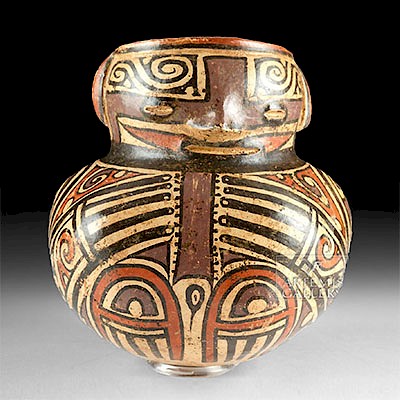Tairona Brecciated Jasper Spoon w/ Spiral Pattern
Lot 87
About Seller
Artemis Gallery
686 S Taylor Ave, Ste 106
Louisville, CO 80027
United States
Selling antiquities, ancient and ethnographic art online since 1993, Artemis Gallery specializes in Classical Antiquities (Egyptian, Greek, Roman, Near Eastern), Asian, Pre-Columbian, African / Tribal / Oceanographic art. Our extensive inventory includes pottery, stone, metal, wood, glass and textil...Read more
Estimate:
$1,000 - $1,500
Absentee vs Live bid
Two ways to bid:
- Leave a max absentee bid and the platform will bid on your behalf up to your maximum bid during the live auction.
- Bid live during the auction and your bids will be submitted real-time to the auctioneer.
Bid Increments
| Price | Bid Increment |
|---|---|
| $0 | $25 |
| $300 | $50 |
| $1,000 | $100 |
| $2,000 | $250 |
| $5,000 | $500 |
| $10,000 | $1,000 |
| $20,000 | $2,500 |
| $50,000 | $5,000 |
| $100,000 | $10,000 |
| $200,000 | $20,000 |
About Auction
By Artemis Gallery
Nov 8, 2018
Set Reminder
2018-11-08 10:00:00
2018-11-08 10:00:00
America/New_York
Bidsquare
Bidsquare : Ancient / Ethnographic From Around The World
https://www.bidsquare.com/auctions/artemis-gallery/ancient-ethnographic-from-around-the-world-3598
Ancient art from Egypt, Greece, Italy and the Near East, as well as Asian, Pre-Columbian, Native American, African / Tribal / Oceanic, Spanish Colonial, Russian Icons, Fine art, much more! Artemis Gallery info@artemisgallery.com
Ancient art from Egypt, Greece, Italy and the Near East, as well as Asian, Pre-Columbian, Native American, African / Tribal / Oceanic, Spanish Colonial, Russian Icons, Fine art, much more! Artemis Gallery info@artemisgallery.com
- Lot Description
Pre-Columbian, Colombia, Tairona, ca. 1000 to 1500 CE. A lengthy hand-carved drug implement with a receptacle at one end for grinding lime powder to mix with coca leaves to permit and facilitate the narcotic substance easier access to the bloodstream. A small knob-shaped grip projects from the back of the receptacle and allows the user to better grasp and control the spoon. Fashioned from a mottled red stone with white inclusions known as brecciated jasper, this tool has a spiralized body similar in form to an elongated spire mollusk shell. Custom museum-quality display stand included. Size: 1" W x 8.375" H (2.5 cm x 21.3 cm); 9" H (22.9 cm) on included custom stand.
According to the Tairona Heritage Trust, "The word 'coca' derives from an Aymara word that means simply 'tree'. Prior to the Conquest, Indians used various names for the several varieties of cultivated Erythroxylum. The Spanish took the name 'coca' from the southern reaches of the Incan empire and bought it into use throughout their domain . . . Coca chewing suffused South American life and the stimulant properties of its leaves have been known from at least the Nazca period (around 500 CE). 'We know this because of the discovery of the mummified remains of a Peruvian potentate of this era accompanied by several bags of coca leaves. In addition, pottery of this period frequently depicts coca chewers with their characteristic distended cheeks.' (Mann J.)" (http://tairona.myzen.co.uk/index.php/culture/the_use_of_coca_in_south_america)
Provenance: private California, USA collection
All items legal to buy/sell under U.S. Statute covering cultural patrimony Code 2600, CHAPTER 14, and are guaranteed to be as described or your money back.
A Certificate of Authenticity will accompany all winning bids.
We ship worldwide and handle all shipping in-house for your convenience.
#135360Repair to two lengthwise halves with small chips and light adhesive residue along break lines. Old loss to tip that was repaired in ancient times. Surface wear and minor abrasions commensurate with age, small chips and nicks to frontal knob handle, bowl periphery, and body, with some roughness along base and knob. Light earthen deposits throughout. Old inventory label on back of receptacle.Condition
- Shipping Info
-
All shipping is handled in-house for your convenience. Your invoice from Artemis Gallery will include shipping calculation instructions. If in doubt, please inquire BEFORE bidding for estimated shipping costs for individual items.
-
- Buyer's Premium



 EUR
EUR CAD
CAD AUD
AUD GBP
GBP MXN
MXN HKD
HKD CNY
CNY MYR
MYR SEK
SEK SGD
SGD CHF
CHF THB
THB














